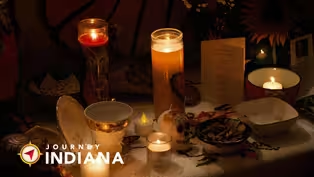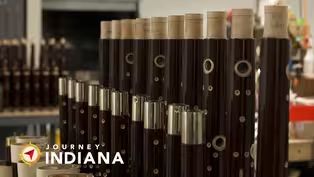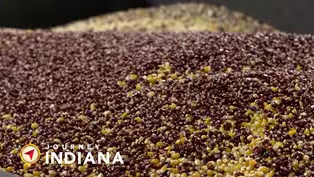Journey Indiana
Casting Community: Artists Learn Iron Pouring at this Annual Southern Indiana Workshop
Clip: Season 7 Episode 3 | 6m 40sVideo has Closed Captions
Each Summer, an Indiana workshop lets young artists design and pour their own cast iron sculptures.
The Sculpture Trails Outdoor Museum, in Southern Indiana’s Greene County, offers visitors a fresh alternative to the typical fine art gallery. But each Summer these quiet hills are brought to life as dozens of artists gather to do something spectacular – design and pour their own cast iron sculptures.
Problems playing video? | Closed Captioning Feedback
Problems playing video? | Closed Captioning Feedback
Journey Indiana is a local public television program presented by WTIU PBS
Journey Indiana
Casting Community: Artists Learn Iron Pouring at this Annual Southern Indiana Workshop
Clip: Season 7 Episode 3 | 6m 40sVideo has Closed Captions
The Sculpture Trails Outdoor Museum, in Southern Indiana’s Greene County, offers visitors a fresh alternative to the typical fine art gallery. But each Summer these quiet hills are brought to life as dozens of artists gather to do something spectacular – design and pour their own cast iron sculptures.
Problems playing video? | Closed Captioning Feedback
How to Watch Journey Indiana
Journey Indiana is available to stream on pbs.org and the free PBS App, available on iPhone, Apple TV, Android TV, Android smartphones, Amazon Fire TV, Amazon Fire Tablet, Roku, Samsung Smart TV, and Vizio.
Providing Support for PBS.org
Learn Moreabout PBS online sponsorship♪ >> The Sculpture Trails Outdoor Museum, located in southern Indiana's Greene County, offers visitors a fresh alternative to a typical fine art gallery.
>> So Sculpture Trails Outdoor Museum is -- it's a nonprofit.
It's designed to help the community learn about sculpture in a hands-on way.
>> Sculptor Gerry Masse created the museum in the early 2000s, when he began installing his and his colleagues' work here on family property.
Today, the museum boasts three miles of trails and nearly 200 sculptures.
>> If you love the arts and you love nature, it's a really cool place to come and hang out.
♪ >> But each summer, these quiet hills are brought to life as dozens of artists gather to do something spectacular, design and pour their own cast iron sculptures.
>> Woo!
>> Thank you!
>> So when artists want to cast iron, a lot of times they can't in their own studio all by themselves, mainly because it really takes a team.
>> And that's why for more than a decade, Gerry has been inviting aspiring cast iron artists from around the world to come to Sculpture Trails for an intensive four-week internship.
>> This internship program is a fantastic opportunity, because there's literally 20 to 30 artists the whole entire month working together as a team.
Producing stuff that there's no way they could produce on their own.
And, in fact, they may never produce something like that again.
By the time they're done with their internship, they will have cast at least 20 to 30,000 pounds of iron, produced over 60,000 pounds of sand molds, and that's usually more than students will get in five years of college.
So the internship has become quite known around the world.
>> The process of creating a cast iron sculpture is long and labor intensive, and it starts with sourcing raw materials.
Each morning scrap iron is broken up and sorted into tidy batches for melting.
Coke, a coal-based fuel, is also sorted into batches.
As for the sculptures, they usually begin with a pattern.
>> A lot of artists like to use Styrofoam, wax, oil-based clay, wood, and it's usually whatever they're comfortable working with.
>> The finished patterns are carefully packed with a sand-glue mixture which dries into a rock hard mold.
Once the sand is set, the patterns are removed, and the hollow molds are prepped to receive molten iron.
♪ >> Then comes the fun part.
As night sets in, the furnace is loaded with layers of coke and iron and ignited.
As temperatures rise above 2200 degrees Fahrenheit, liquid iron drips its way to the base of the furnace, delivering several hundred pounds of molten metal every few minutes.
>> When we pour at night, it feels like magic.
You just finished pouring one ladle, and then another one is coming straight from the furnace.
So it's like, boom, boom, boom, boom, boom, boom.
But then there are moments where you can just stand and look at the furnace, and you're like, wow!
This is really happening right now.
There's molten metal in that furnace, and I'm gonna have it in about ten seconds flat.
Art is great and sculpture is great, but metal casting, like you don't do that anywhere else, and you can't do it the way that we do it here anywhere else.
>> Professional artists can also book one to three weeks on site, taking advantage of this temporary iron foundry to pursue any projects that they wish.
>> I'm coming from west Texas.
That's where my studio is.
This is my ninth year.
I love Sculpture Trails because it's -- this is a place where I can experiment, right?
That means I get to test ideas, see something being made.
Pour this thing, crack it open the next day, and then respond to it.
And that really fits the way that I'm an artist, and there aren't other places that I can do that.
>> That freedom to experiment isn't accidental.
>> Cast iron is new, I would say since the 1950s and '60s.
Iron really gives sculptors a chance to be free, and really don't worry about history.
Another thing that they can put aside and just use their own artistic voice.
And to me, Sculpture Trails is here to help that push.
>> I've never worked in a place where you've got people who are in charge, who are so passionate about what they're doing.
They aren't looking for people who are extremely knowledged in the sector.
They are using the space to teach people who are interested in it, and I think that that is exactly what internships are about.
And it's hard to find internships like that.
>> Once the casts have cooled, the molds are broken up to reveal the new sculptures within.
And many of them will find a home at the Sculpture Trails.
>> All the cast iron sculpture that's made this month, it will either end up in two spots.
It could be entered into our cast iron exhibition, and that's a two-year ongoing show for these artists.
We'll only pick maybe 10 to 20.
All the other things, they just go off home with the artist.
They sell 'em, they put them in galleries, who knows.
They could stick 'em in the garden.
>> Whether they end up in a garden, a gallery or right here on the trails, these sculptures will remain sturdy reminders of all the hard work and community building taking place here summer after summer.
>> I think the exposure to a lot of people that are just like them is what -- the main thing they are going to get out of it, besides all the experience and an awesome resume.
They don't realize, they're going to stay working in this field, and they're going to need each other's help.
Art of the Ancestors: How Connecting with Mexican Traditions Helped Emily Guerrero Heal
Video has Closed Captions
Clip: S7 Ep3 | 5m 55s | Emily Guerrero creates large public art exhibits known in her Mexican culture as ofrendas. (5m 55s)
Instrumental in Indiana: The Story of Fox Products
Video has Closed Captions
Clip: S7 Ep3 | 6m 7s | Fox Products makes world class musical instruments right here in Indiana. (6m 7s)
Top of the Pops: Amish Country Popcorn Helps Keep Indiana #1 Producer
Video has Closed Captions
Clip: S7 Ep3 | 3m 42s | When it comes to popcorn Indiana is #1! Why do we still love this snacking staple? (3m 42s)
Providing Support for PBS.org
Learn Moreabout PBS online sponsorshipSupport for PBS provided by:
Journey Indiana is a local public television program presented by WTIU PBS
















